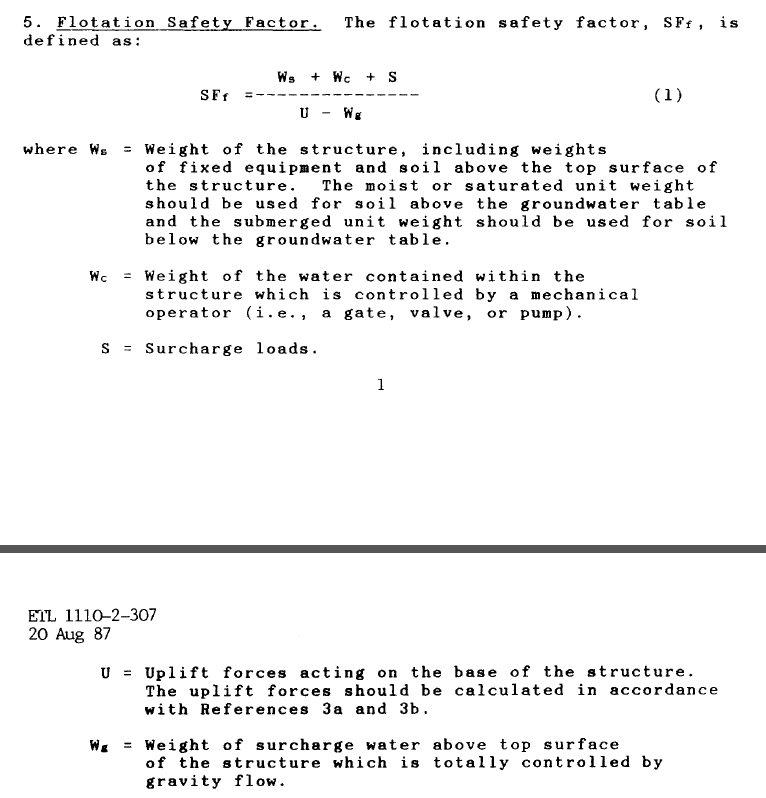Ricyteach
Geotechnical
- Sep 28, 2011
- 27
What design standards exist for the design of ballast against uplift forces, and what factor of safety against uplift do these design standards promulgate? I am familiar with a typical FS of roughly 1.5 against sliding forces due to active soil pressure for the design of many types of structures (including cantilevered retaining walls and gravity dams), but I am not aware of any such standard FS against uplift.
It is possible- perhaps likely- that the safety factor can vary depending on the nature of the loading. Specifically I have in mind uplift due to wind. But other forms of applied uplift may include: buoyant forces, dynamic/static pressure applied by some other fluid (e.g., water, etc.), and load transference forces (perhaps in a machine where ballast is used to counteract forces applied to some arm/member).
The way I have done this in the past is to use standard load combination equations in design codes. For example, the ASCE 7 load combinations for design of the limit state considering wind uplift are as follows:
# 7 ASD: 0.6D + 1.0Wworking_stress/service~state (note that in ASCE 7 2010, W = 1.67 Wworking_stress)
# 6 Strength design: 0.9D + 1.67 Wworking_stress/service~state
However, the problem with this approach is twofold.
First, using these load combinations directly leads two different, inconsistent effective factors of safety:
7. Effective FS_{ASD~Method} = 1.0/0.6 = 1.67
6. Effective FS {Strength~Method} = 1.67/0.9 = 1.85
Secondly, the intention of a design code such as ASCE 7 is to provide guidance for the *load side* of the design equation. The *resistance side* of the design equation is usually left to the various engineering groups/societies who publish standards for different materials used to resist loads, e.g. the American Concrete Institute (ACI), or the American Institute of Steel Construction (AISC). These groups provide standard factors of safety (ASD design) and resistance factors (LRFD design). However as far as I am aware, there is no American Institute of Ballast.
Also note that for this question I am not considering uplift due to seismic forces, because seismic events occur in the form of a spectral acceleration which *results* in a force, and that force gets higher as the mass of the ballast increases. Therefore ballast is not effective on its own in preventing uplift due to seismic acceleration.
It is possible- perhaps likely- that the safety factor can vary depending on the nature of the loading. Specifically I have in mind uplift due to wind. But other forms of applied uplift may include: buoyant forces, dynamic/static pressure applied by some other fluid (e.g., water, etc.), and load transference forces (perhaps in a machine where ballast is used to counteract forces applied to some arm/member).
The way I have done this in the past is to use standard load combination equations in design codes. For example, the ASCE 7 load combinations for design of the limit state considering wind uplift are as follows:
# 7 ASD: 0.6D + 1.0Wworking_stress/service~state (note that in ASCE 7 2010, W = 1.67 Wworking_stress)
# 6 Strength design: 0.9D + 1.67 Wworking_stress/service~state
However, the problem with this approach is twofold.
First, using these load combinations directly leads two different, inconsistent effective factors of safety:
7. Effective FS_{ASD~Method} = 1.0/0.6 = 1.67
6. Effective FS {Strength~Method} = 1.67/0.9 = 1.85
Secondly, the intention of a design code such as ASCE 7 is to provide guidance for the *load side* of the design equation. The *resistance side* of the design equation is usually left to the various engineering groups/societies who publish standards for different materials used to resist loads, e.g. the American Concrete Institute (ACI), or the American Institute of Steel Construction (AISC). These groups provide standard factors of safety (ASD design) and resistance factors (LRFD design). However as far as I am aware, there is no American Institute of Ballast.
Also note that for this question I am not considering uplift due to seismic forces, because seismic events occur in the form of a spectral acceleration which *results* in a force, and that force gets higher as the mass of the ballast increases. Therefore ballast is not effective on its own in preventing uplift due to seismic acceleration.


